Key Points:
- Asia contains many of the very largest snakes in the world.
- There are a variety of types of snakes that make this list, not just all pythons.
- Because of this, some are venomous and some are not.
Snakes live worldwide in a wide variety of habitats, but the ten largest snakes in Asia are enough to give anyone chills. Some of the snakes on our list are harmless, while others have a bite that can kill a person if left untreated. A few of the biggest snakes on our list of the largest snakes in Asia don’t kill with venom, though. Instead, they use the crushing weight of their body to constrict prey to death.
Read on to learn more about Asia’s biggest snakes.
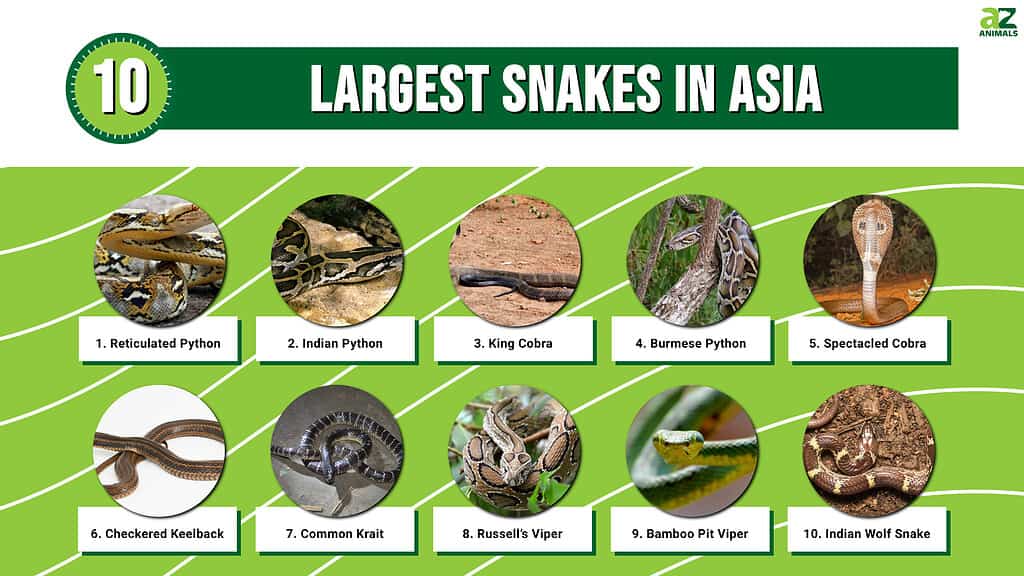
10. Indian Wolf Snake (Lycodon aulicus)
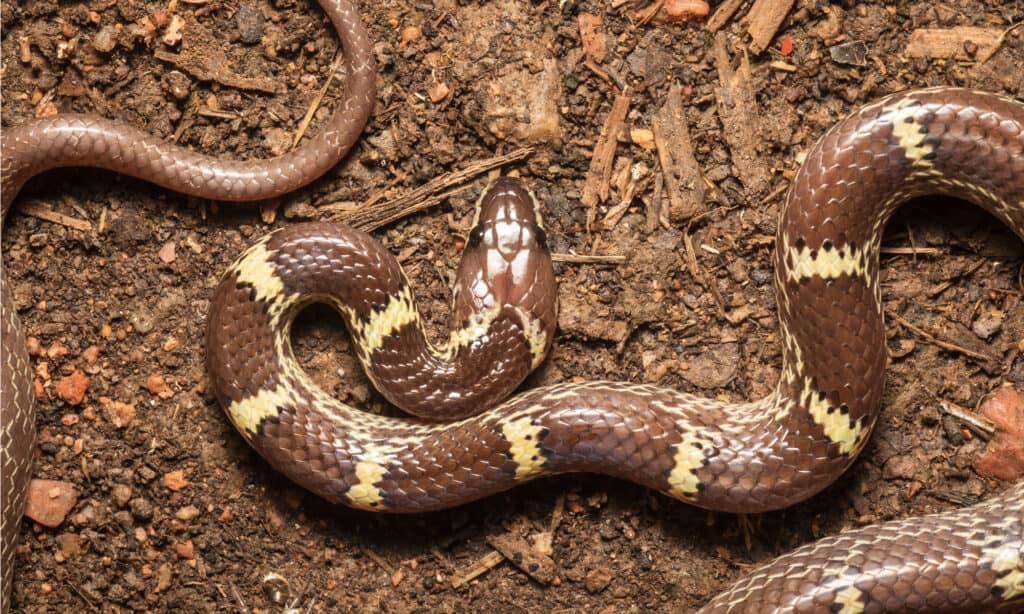
Indian
wolf snakes
live throughout Southeast Asia and India as far north as Pakistan.
©sushil kumudini chikane/Shutterstock.com
The Indian wolf snake certainly isn’t the largest snake in Asia, but it can grow up to three feet long. They have highly variable coloring but always have dark bodies with thin stripes running down the body. Indian wolf snakes aren’t venomous and pose little threat to humans.
9. Bamboo Pit Viper (Craspedocephalus gramineus)
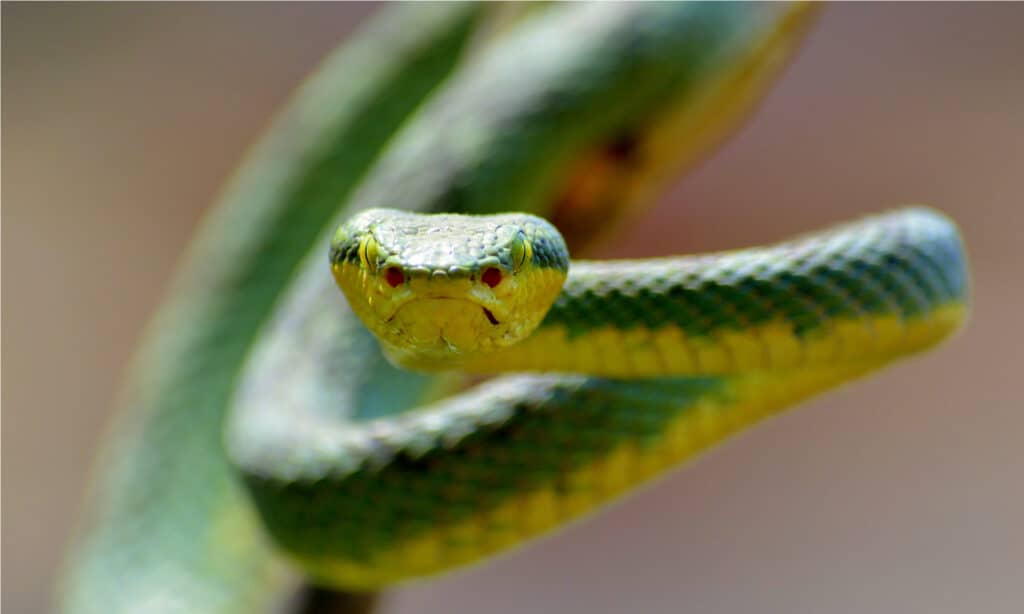
The bamboo pit viper is also known as the Indian green pit viper or the common green pit viper.
©PratikPatel4664/Shutterstock.com
Bamboo pit vipers grow to a maximum length of about 3.5 feet. They’re brightly colored, with dark green backs and sides and lime green undersides. Even their eyes are bright green. They’re localized to southern India and some parts of northern India. Bamboo pit vipers have highly toxic venom, and don’t hesitate to use it if people stray too near.
8. Russell’s Viper (Daboia russelii)
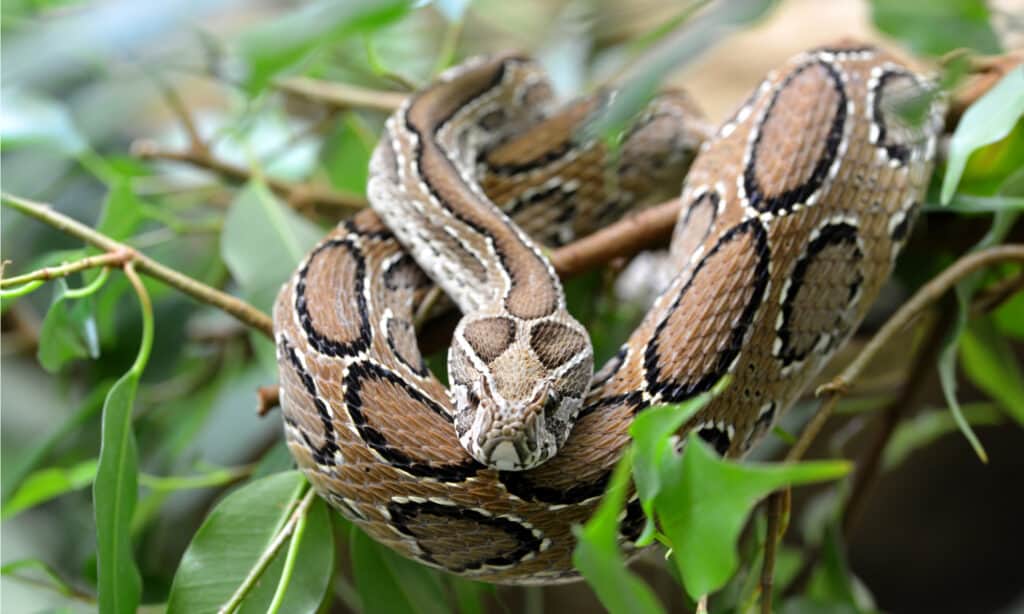
The Russell’s viper is one of four snake species in India that, together, cause more snakebites than any other species.
©jaroslava V/Shutterstock.com
These snakes have some of the most distinctive markings of any snake in Asia. They have sand-colored bodies with distinct dark brown ovoid splotches. Russell’s vipers have heavy bodies with triangular heads. They grow to a maximum length of about four feet. Like the spectacled cobra, they inhabit the Indian subcontinent, though they tend to stay away from watery areas like marshes and rainforests.
7. Common Krait (Bungarus caeruleus)
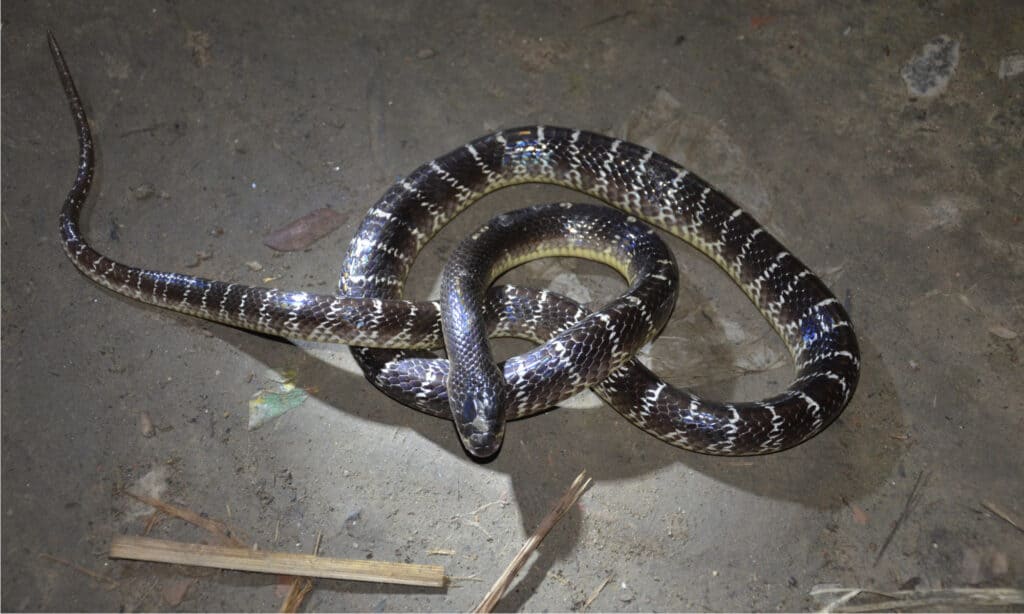
The common
krait
is a type of sea snake; it is also known as the blue krait.
©Arabindu Sardar/Shutterstock.com
Common kraits are one of the largest snakes in Asia, particularly among water-loving snakes. They grow to a maximum length of nearly six feet and have long, thin bodies adapted for semi-aquatic living. Common kraits have narrow heads with small eyes. They’re generally brown with thin, tan-colored stripes along their bodies. They live in a few restricted areas of India, almost always near a source of permanent water.
6. Checkered Keelback (Fowlea piscator)
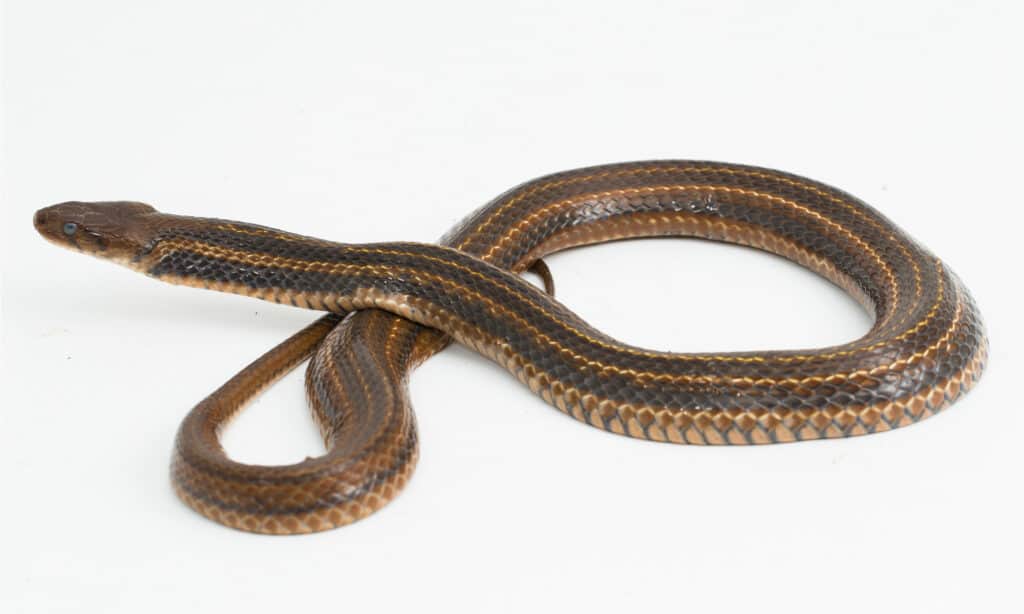
Checkered keelbacks are also known as Asiatic water snakes because of their mostly aquatic lifestyle.
©dwi putra stock/Shutterstock.com
The checkered keelback has one of the most distinctive patterns of any snake. It has a base color of light brown to brown-green, with darker squares arranged in a checkerboard pattern. This species can reach lengths of nearly six feet and are most often found in or near sources of water.
5. Spectacled Cobra (Naja naja)
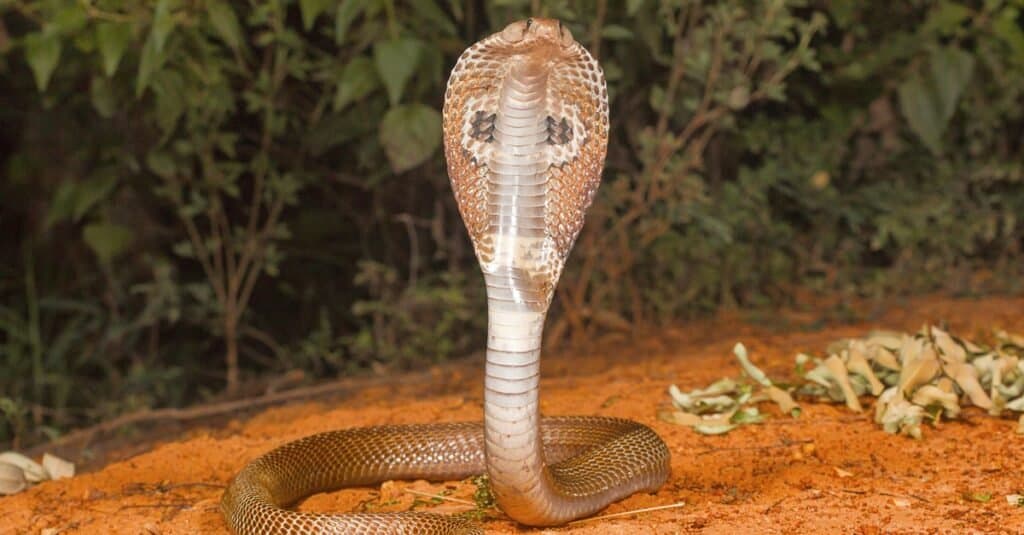
The spectacled cobra is also known as the Asian cobra, Indian cobra, or binocellate cobra.
©RealityImages/Shutterstock.com
These snakes have heavy bodies with wide hoods and spectacle-like markings on their throats and the backs of their necks. Spectacled cobras grow up to seven feet in length in certain areas, though most reach only five feet. They’re highly venomous and made famous by snake charmers. Spectacled cobras live throughout the Indian subcontinent, generally near sources of water.
4. Burmese Python (Python Bivittatus)
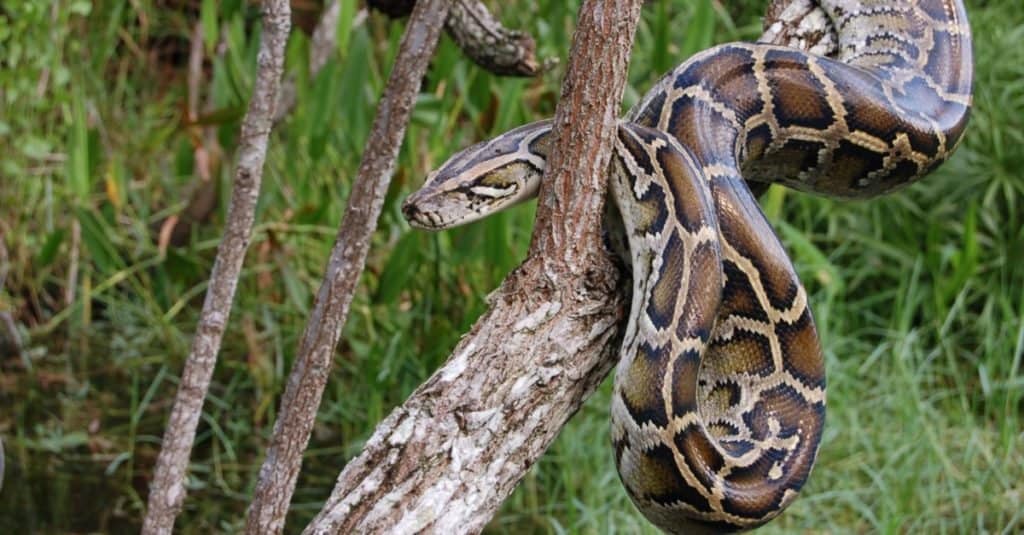
Popular as pets,
Burmese
pythons are listed as vulnerable in their native Southeast Asia.
©Heiko Kiera/Shutterstock.com
One of the largest snakes in Asia, Burmese pythons can grow up to 16 feet long and weigh more than 150 pounds. Females are significantly larger than males, who grow to a maximum length of about ten feet. Burmese pythons have very heavy bodies with stark yellow and dark brown markings. They live throughout India and Southeast Asia, and even as far north as Nepal and as far south as Indonesia.
3. King Cobra (Ophiophagus hannah)
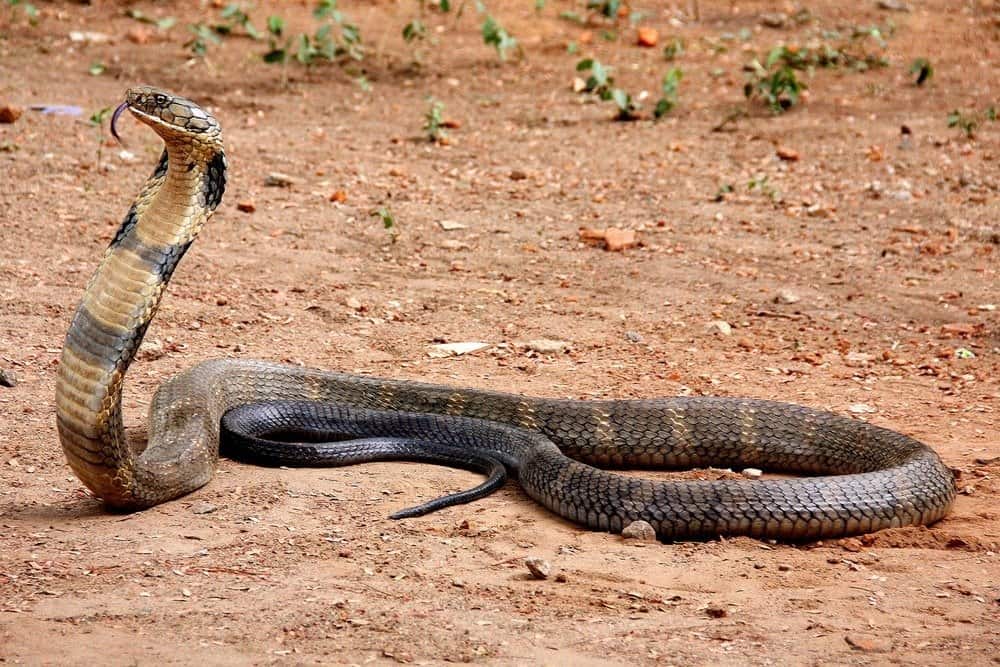
Despite their fearsome appearance, king cobras rarely attack humans and would rather flee than fight.
©Jolly Therattil/Shutterstock.com
King cobras have the distinction of being the longest venomous snakes in the world. They make it to number three on our list of largest snakes in Asia, and their bronze medal is well deserved. King cobras can grow to over 19 feet long, with slender, muscular bodies and wide hoods. They’re mostly black, with thin semi-distinct white bands and pale yellow necks with black markings. King cobras are listed as vulnerable in their native Southeast Asia.
2. Indian Python (Python Molurus)
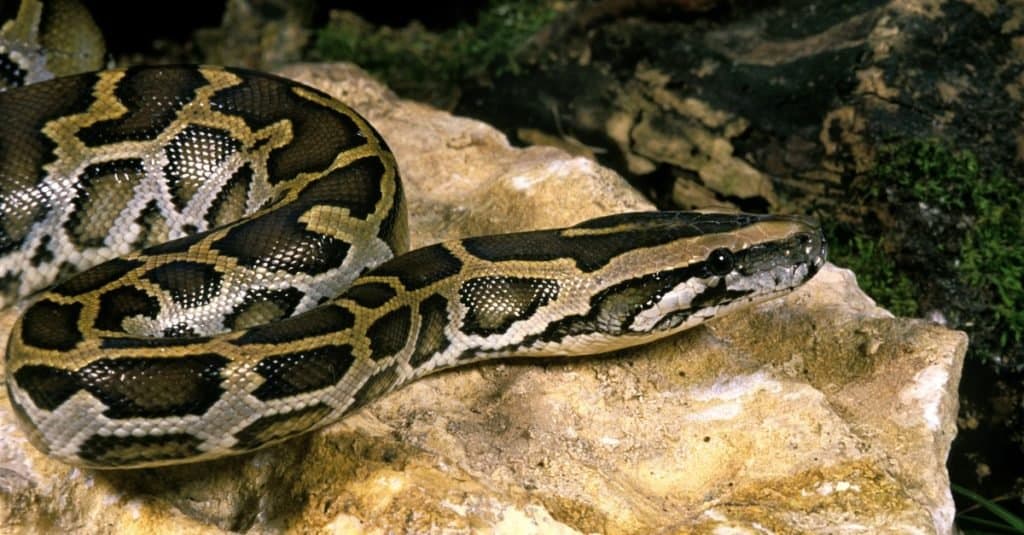
The Indian python is also known as the Asian rock python, Indian rock python, or black-tailed python.
©slowmotiongli/Shutterstock.com
The second-largest snake in Asia is the Indian python. Indian pythons grow up to 12 feet long and can weigh over 100 pounds. They live throughout the entire Indian subcontinent and on the island of Sri Lanka. Like Burmese pythons, they have light tan bodies with distinct brown markings. They eat mostly small to medium-sized mammals but won’t say no to birds or reptiles either.
1. Reticulated Python (Malayopython reticulatus)
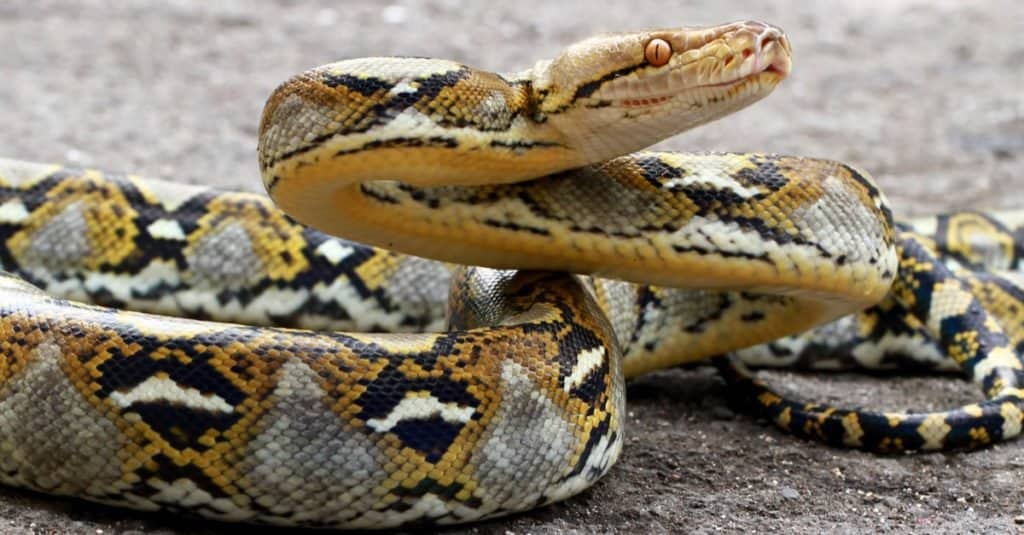
The reticulated python isn’t just the biggest snake in Asia, it’s also the biggest snake on Earth.
©Opayaza12/Shutterstock.com
Number one on our list of the largest snakes in Asia is the reticulated python. Reticulated pythons are the longest snakes in the world, and they’re tied with two other species for the heaviest. Reticulated pythons can grow to over 20 feet long and weigh over 160 pounds. They’re native to Southeast Asia, though there is a substantial population of invasive reticulated pythons in Florida. Reticulated pythons are so big that they can kill and eat deer and other medium-sized mammals.
These mammoths can have a fairly long lifespan for snakes, and they can live all the way up to 20 years in the wild! Reptiles on average live longer than mammals of similar sizes, and their cells don’t appear to show signs of aging as dramatically as other animals.
Summary of the 10 Largest Snakes in Asia
Here’s a recap of the 10 biggest snakes found in Asia that we took a look at:
| Rank | Snake | Scientific Name | Length |
|---|---|---|---|
| 1 | Reticulated Python | Malayopython reticulatus | Over 20 feet |
| 2 | Indian Python | Python Molurus | Up to 12 feet |
| 3 | King Cobra | Ophiophagus hannah | Over 19 feet |
| 4 | Burmese Python | Python Bivittatus | 16 feet |
| 5 | Spectacled Cobra | Naja naja | 7 feet |
| 6 | Checkered Keelback | Fowlea piscator | Nearly 6 feet |
| 7 | Common Krait | Bungarus caeruleus | Nearly 6 feet |
| 8 | Russell’s Viper | Daboia russelii | 4 feet |
| 9 | Bamboo Pit Viper | Craspedocephalus gramineus | 3.5 feet |
| 10 | Indian Wolf Snake | Lycodon aulicus | 3 feet |
The photo featured at the top of this post is © Opayaza12/Shutterstock.com
Discover the "Monster" Snake 5X Bigger than an Anaconda
Every day A-Z Animals sends out some of the most incredible facts in the world from our free newsletter. Want to discover the 10 most beautiful snakes in the world, a "snake island" where you're never more than 3 feet from danger, or a "monster" snake 5X larger than an anaconda? Then sign up right now and you'll start receiving our daily newsletter absolutely free.
Thank you for reading! Have some feedback for us? Contact the AZ Animals editorial team.






